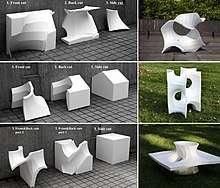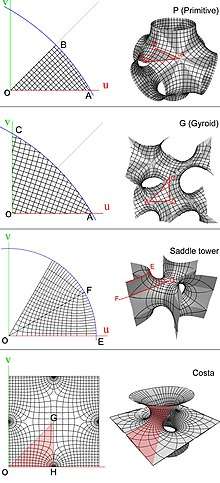Weierstrass–Enneper parameterization
In mathematics, the Weierstrass–Enneper parameterization of minimal surfaces is a classical piece of differential geometry.
Alfred Enneper and Karl Weierstrass studied minimal surfaces as far back as 1863.

Let ƒ and g be functions on either the entire complex plane or the unit disk, where g is meromorphic and ƒ is analytic, such that wherever g has a pole of order m, f has a zero of order 2m (or equivalently, such that the product ƒg2 is holomorphic), and let c1, c2, c3 be constants. Then the surface with coordinates (x1,x2,x3) is minimal, where the xk are defined using the real part of a complex integral, as follows:
The converse is also true: every nonplanar minimal surface defined over a simply connected domain can be given a parametrization of this type.[1]
For example, Enneper's surface has ƒ(z) = 1, g(z) = z^m.
Parametric surface of complex variables
The Weierstrass-Enneper model defines a minimal surface () on a complex plane (). Let (the complex plane as the space), we write the Jacobian matrix of the surface as a column of complex entries:
Where and are holomorphic functions of .
The Jacobian represents the two orthogonal tangent vectors of the surface:[2]
The surface normal is given by
The Jacobian leads to a number of important properties: , , , . The proofs can be found in Sharma's essay: The Weierstrass representation always gives a minimal surface.[3] The derivatives can be used to construct the first fundamental form matrix:
and the second fundamental form matrix
Finally, a point on the complex plane maps to a point on the minimal surface in by
where for all minimal surfaces throughout this paper except for Costa's minimal surface where .
Embedded minimal surfaces and examples
The classical examples of embedded complete minimal surfaces in with finite topology include the plane, the catenoid, the helicoid, and the Costa's minimal surface. Costa's surface involves Weierstrass's elliptic function :[4]
where is a constant [5] (Chapter 22).
_and_the_3D_surfaces._The_continuous_surfaces_are_made_of_copies_of_the_fundamental_patch_(R3).jpg)
Lines of curvature
One can rewrite each element of second fundamental matrix as a function of and , for example
And consequently we can simplify the second fundamental form matrix as

One of its eigenvectors is
which represents the principal direction in the complex domain.[6] Therefore, the two principal directions in the space turn out to be
See also
- Associate family
- Bryant surface, found by an analogous parameterization in hyperbolic space
References
- Dierkes, U., Hildebrandt, S., Küster, A., Wohlrab, O. Minimal surfaces, vol. I, p. 108. Springer 1992. ISBN 3-540-53169-6
- Andersson, S., Hyde, S.T., Larsson, K., Lidin, S.: Minimal surfaces and structures: from inorganic and metal crystals to cell membranes and biopolymers. Chem. Rev. 88(1), 221–242 (1988)
- Sharma, R.: The weierstrass representation always gives a minimal surface. arXiv preprint arXiv:1208.5689 (2012)
- Lawden, D.F.: Elliptic Functions and Applications, vol. 80. Springer, Berlin (2013)
- Abbena, E., Salamon, S., Gray, A.: Modern Differential Geometry of Curves and Surfaces with Mathematica. CRC Press, Boca Raton (2006)
- Hua, H. and Jia, T., 2018. Wire cut of double-sided minimal surfaces. The Visual Computer, 34(6-8), pp.985-995.